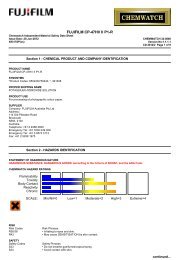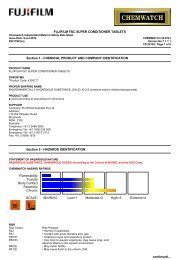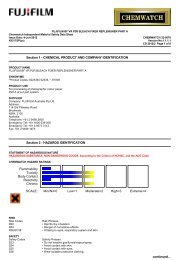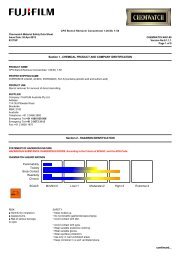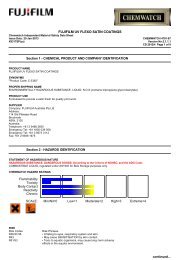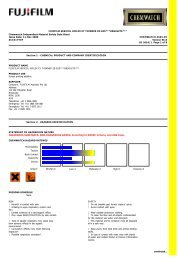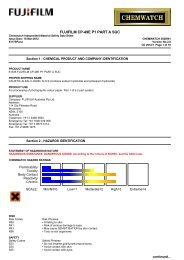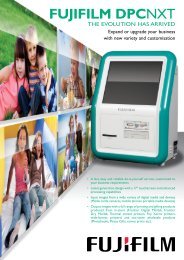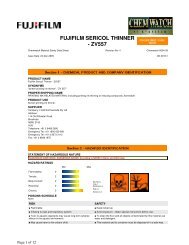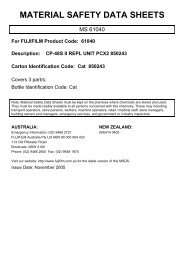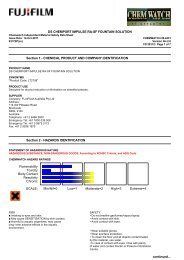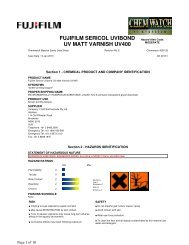Chemwatch MSDS Print - FUJIFILM Australia
Chemwatch MSDS Print - FUJIFILM Australia
Chemwatch MSDS Print - FUJIFILM Australia
Create successful ePaper yourself
Turn your PDF publications into a flip-book with our unique Google optimized e-Paper software.
<strong>FUJIFILM</strong> SERICOL DIRASOL 125<br />
Hazard Alert Code: NIL<br />
<strong>Chemwatch</strong> Material Safety Data Sheet<br />
Issue Date: 16-Apr-2010 CHEMWATCH 4600-66<br />
XC9317SC<br />
Version No:4<br />
CD 2010/3 Page 3 of 5<br />
Section 6 - ACCIDENTAL RELEASE MEASURES<br />
• Alert Fire Brigade and tell them location and nature of hazard.<br />
• Control personal contact by using protective equipment as required.<br />
• Prevent spillage from entering drains or water ways.<br />
Personal Protective Equipment advice is contained in Section 8 of the <strong>MSDS</strong>.<br />
Section 7 - HANDLING AND STORAGE<br />
PROCEDURE FOR HANDLING<br />
• Limit all unnecessary personal contact.<br />
• Wear protective clothing when risk of exposure occurs.<br />
• Use in a well-ventilated area.<br />
• Avoid contact with incompatible materials.<br />
SUITABLE CONTAINER<br />
• Polyethylene or polypropylene container.<br />
• Packing as recommended by manufacturer.<br />
• Check all containers are clearly labelled and free from leaks.<br />
STORAGE INCOMPATIBILITY<br />
■ Avoid contamination of water, foodstuffs, feed or seed. None known.<br />
STORAGE REQUIREMENTS<br />
• Store in original containers.<br />
• Keep containers securely sealed.<br />
• Store in a cool, dry, well-ventilated area.<br />
• Store away from incompatible materials and foodstuff containers.<br />
Section 8 - EXPOSURE CONTROLS / PERSONAL PROTECTION<br />
EXPOSURE CONTROLS<br />
The following materials had no OELs on our records<br />
• water: CAS:7732- 18- 5<br />
PERSONAL PROTECTION<br />
EYE<br />
• Safety glasses with side shields<br />
• Chemical goggles.<br />
• Contact lenses may pose a special hazard; soft contact lenses may absorb and concentrate irritants. A written policy document, describing the<br />
wearing of lens or restrictions on use, should be created for each workplace or task. This should include a review of lens absorption and<br />
adsorption for the class of chemicals in use and an account of injury experience. Medical and first-aid personnel should be trained in their<br />
removal and suitable equipment should be readily available. In the event of chemical exposure, begin eye irrigation immediately and remove contact<br />
lens as soon as practicable. Lens should be removed at the first signs of eye redness or irritation - lens should be removed in a clean environment<br />
only after workers have washed hands thoroughly. [CDC NIOSH Current Intelligence Bulletin 59].<br />
HANDS/FEET<br />
■ Wear general protective gloves, eg. light weight rubber gloves.<br />
OTHER<br />
■ No special equipment needed when handling small quantities.<br />
OTHERWISE:<br />
• Overalls.<br />
• Barrier cream.<br />
• Eyewash unit.<br />
ENGINEERING CONTROLS<br />
■ General exhaust is adequate under normal operating conditions. If risk of overexposure exists, wear SAA approved respirator.<br />
continued...



